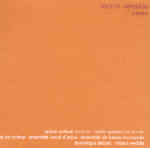The origins of Iannis Xenakis’ Oresteïa are almost more remarkable than the music itself, a truly bizarre “only in the USA” sort of story. Sometime in the 1960s the town of Ypsilanti, Michigan discovered that its name was not derived from some Native American language, but rather from Greek. Filled with pride at its newfound ethnic association, the town decided to hold a Greek festival capped by performances of The Birds and Oresteïa in a Greek-style amphitheater constructed on the local university baseball field. They hired an authentic Greek director and also agreed to engage the services of an authentic Greek composer to write the incidental score. Xenakis, in turn, fired with enthusiasm for the project, wrote more than an hour and a half of music for the production, which by all accounts was a huge success. In order to salvage the work for concert performance, Xenakis later prepared a cantata lasting around 50 minutes, adding in the mid-1980s the movement “Kassandra”–and here we have the result.
Okay, so it’s not exactly as easy to listen to as Prokofiev’s Alexander Nevsky, another cantata that grew out of, shall we say, populist roots (in this case a film score), but anyone who thinks that Xenakis is unapproachable might hear Oresteïa and reconsider this hasty judgment. What gives this music its strange fascination is the combination of generally tonal, chant-like vocal elements with primitive sounding (but actually very technically sophisticated) instrumental interludes. In this respect we’re not so far away from Stravinsky’s The Rite of Spring, the vocal works of Varèse, or (perish the thought) the later settings of Greek drama by Carl Orff. You can hear this very clearly in the second movement, Kassandra, with its delirious writing for percussion and high baritone, as well as in the chanting of the chorus in Les Choephores. The stylized instrumental writing, often monophonic and permeated with strange percussion sounds and extremes of pitch (both high and low), adds to the impression of primal starkness, and how well it suits the drama!
So where’s the snake in this particular avant-garde Eden? Here it is: Montaigne can’t find room in its cheap and flimsy paper package for the texts. You would think by now that any record company with even a shred of pride would understand that it’s worth it to charge a few pennies more to let people serious about music understand what all of the screaming’s about. Sure, we know the story (Agamemnon, Elektra, Klytemnestra–it’s all been done before); but much as Xenakis disliked merely descriptive music, his settings go hand in hand with the words, and to miss them is to miss much of the music’s point, however fascinating and evocative it may be as pure sound. So what could have served as an ideal introduction (in this very fine and well recorded performance) to a fascinating and original composer winds up being just another specialty item for the already converted. God, what a pity!
































